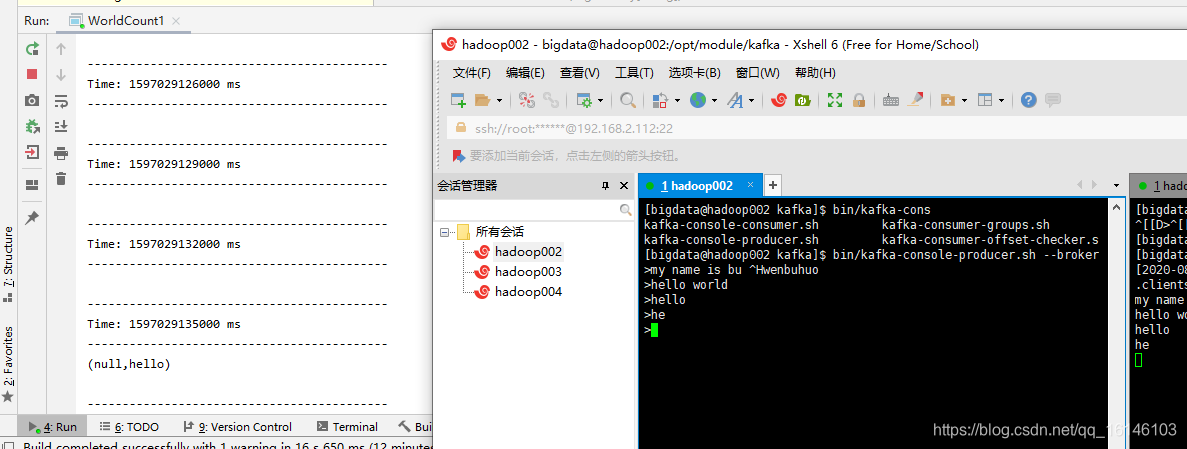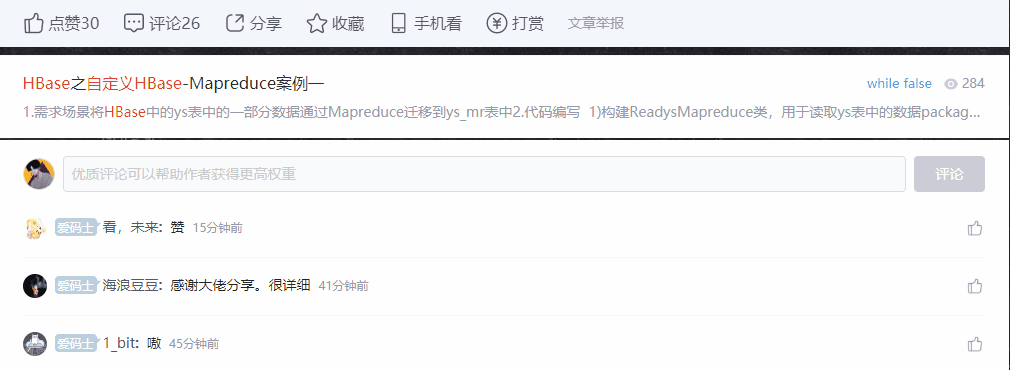Spark Streaming 快速入门系列(3) | DStream中如何创建数据源
大家好,我是不温卜火,是一名计算机学院大数据专业大二的学生,昵称来源于成语—
不温不火,本意是希望自己性情温和。作为一名互联网行业的小白,博主写博客一方面是为了记录自己的学习过程,另一方面是总结自己所犯的错误希望能够帮助到很多和自己一样处于起步阶段的萌新。但由于水平有限,博客中难免会有一些错误出现,有纰漏之处恳请各位大佬不吝赐教!暂时只有csdn这一个平台,博客主页:https://buwenbuhuo.blog.csdn.net/
本片博文为大家带来的是DStream中如何创建数据源。


Spark Streaming 原生支持一些不同的数据源。
一. RDD 队列(测试用)
- 1. 用法及说明
测试过程中,可以通过使用ssc.queueStream(queueOfRDDs)来创建DStream,每一个推送到这个队列中的RDD,都会作为一个DStream处理。
- 2. 案例实操
需求:循环创建几个 RDD,将 RDD 放入队列。通过 Spark Streaming创建 Dstream,计算 WordCount
package com.buwenbuhuo.spark.streaming.day01
import org.apache.spark.{SparkConf, SparkContext}
import org.apache.spark.rdd.RDD
import org.apache.spark.streaming.dstream.{DStream, InputDStream}
import org.apache.spark.streaming.{Seconds, StreamingContext}
import scala.collection.mutable
/**
*
* @author 不温卜火
* @create 2020-08-07 13:08
* MyCSDN : https://buwenbuhuo.blog.csdn.net/
*
*/
object WordCount1 {
def main(args: Array[String]): Unit = { // 从RDD队列中读取数据,仅仅用于压力测试 val conf: SparkConf = new SparkConf().setMaster("local[2]").setAppName("WordCount1") val ssc: StreamingContext = new StreamingContext(conf,Seconds(3)) val rdds: mutable.Queue[RDD[Int]] = mutable.Queue[RDD[Int]]() val sourceStream: InputDStream[Int] = ssc.queueStream(rdds,false) val result: DStream[Int] = sourceStream.reduce(_+_) result.print() ssc.start() val sc: SparkContext = ssc.sparkContext while (true) { rdds.enqueue(sc.parallelize(1 to 100)) Thread.sleep(10) } ssc.awaitTermination()
}
}
- 1
- 2
- 3
- 4
- 5
- 6
- 7
- 8
- 9
- 10
- 11
- 12
- 13
- 14
- 15
- 16
- 17
- 18
- 19
- 20
- 21
- 22
- 23
- 24
- 25
- 26
- 27
- 28
- 29
- 30
- 31
- 32
- 33
- 34
- 35
- 36
- 37
- 38
- 3. 运行结果

二. 自定义数据源
- 1. 使用及说明
其实就是自定义接收器
需要继承Receiver,并实现onStart、onStop方法来自定义数据源采集。
- 2. 需求:
自定义数据源,实现监控某个端口号,获取该端口号内容。
- 3. 源码
package com.buwenbuhuo.spark.streaming.day01
import java.io.{BufferedReader, InputStreamReader}
import java.net.Socket
import org.apache.spark.SparkConf
import org.apache.spark.storage.StorageLevel
import org.apache.spark.streaming.dstream.ReceiverInputDStream
import org.apache.spark.streaming.{Seconds, StreamingContext}
import org.apache.spark.streaming.receiver.Receiver
/**
*
* @author 不温卜火
* @create 2020-08-07 17:03
* MyCSDN : https://buwenbuhuo.blog.csdn.net/
*
*/
object MyReceiverDemo {
def main(args: Array[String]): Unit = { val conf: SparkConf = new SparkConf().setMaster("local[*]").setAppName("MyReceiverDemo") val ssc: StreamingContext = new StreamingContext(conf,Seconds(3)) val sourceStream: ReceiverInputDStream[String] = ssc.socketTextStream("hadoop002",9999) sourceStream .flatMap(_.split(" ")) .map((_,1)) .reduceByKey(_ + _) .print() ssc.start() ssc.awaitTermination()
}
}
// 接收器从socket接受数据
class MyReceiver(host:String,port:Int) extends Receiver[String](storageLevel = StorageLevel.MEMORY_ONLY) { var socket:Socket = _
var reader:BufferedReader = _
override def onStart(): Unit = { runInThread{ try { socket = new Socket(host, port) reader = new BufferedReader(new InputStreamReader(socket.getInputStream, "utf-8")) var line: String = reader.readLine() // 当对方发送一个流结束标志的时候,会受到null while (line != null && socket.isConnected) { store(line) line = reader.readLine() // 如果流中没有数据,这将会一直阻塞 } }catch { case e => e.printStackTrace() }finally { restart("重启服务器") // 自动立即调用onStop,然后再调用onStart } }
} // 在一个子线程中去执行传入的代码
def runInThread(op: => Unit) ={ new Thread(){ override def run():Unit = op }.start()
} // 释放资源
override def onStop(): Unit = { if(socket != null) socket.close() if(reader != null) reader.close()
}
}
- 1
- 2
- 3
- 4
- 5
- 6
- 7
- 8
- 9
- 10
- 11
- 12
- 13
- 14
- 15
- 16
- 17
- 18
- 19
- 20
- 21
- 22
- 23
- 24
- 25
- 26
- 27
- 28
- 29
- 30
- 31
- 32
- 33
- 34
- 35
- 36
- 37
- 38
- 39
- 40
- 41
- 42
- 43
- 44
- 45
- 46
- 47
- 48
- 49
- 50
- 51
- 52
- 53
- 54
- 55
- 56
- 57
- 58
- 59
- 60
- 61
- 62
- 63
- 64
- 65
- 66
- 67
- 68
- 69
- 70
- 71
- 72
- 73
- 74
- 4. 测试结果
nc -lk 9999
- 1


三. Kafka 数据源
1. 准备工作
- 1. 用法及说明
在工程中需要引入 Maven 依赖 spark-streaming-kafka_2.11来使用它。
包内提供的 KafkaUtils 对象可以在 StreamingContext和JavaStreamingContext中以你的 Kafka 消息创建出 DStream。
两个核心类:KafkaUtils、KafkaCluster
- 2. 导入依赖
<dependency> <groupId>org.apache.spark</groupId> <artifactId>spark-streaming-kafka-0-8_2.11</artifactId> <version>2.1.1</version>
</dependency>
- 1
- 2
- 3
- 4
- 5
- 6
- 3. 启动zookeeper和kafka集群
[bigdata@hadoop002 zookeeper-3.4.10]$ bin/start-allzk.sh
[bigdata@hadoop002 kafka]$ start-kafkaall.sh
- 1
- 2

- 4. 开启一个生产者和消费端
// 生产者
[bigdata@hadoop002 kafka]$ bin/kafka-console-producer.sh --broker-list hadoop002:9092 --topic first0810
// 消费者
[bigdata@hadoop002 kafka]$ bin/kafka-console-consumer.sh --bootstrap-server hadoop002:9092 --topic first0810
- 1
- 2
- 3
- 4
- 5

- 5. 通过IDEA接收数据
package com.buwenbuhuo.spark.streaming.day01.kafka
import kafka.serializer.StringDecoder
import org.apache.kafka.clients.consumer.ConsumerConfig
import org.apache.spark.SparkConf
import org.apache.spark.streaming.dstream.InputDStream
import org.apache.spark.streaming.kafka.KafkaUtils
import org.apache.spark.streaming.{Seconds, StreamingContext}
/**
** @author 不温卜火
* @create 2020-08-10 9:34
* MyCSDN : https://buwenbuhuo.blog.csdn.net/
*
*/
object WorldCount1 {
def main(args: Array[String]): Unit = { val conf: SparkConf = new SparkConf().setMaster("local[*]").setAppName("WorldCount1") val ssc = new StreamingContext(conf, Seconds(3)) val params: Map[String, String] = Map[String,String]( "bootstrap.servers" -> "hadoop002:9092,hadoop003:9092,hadoop004:9092", "group.id" -> "0810" ) val srouceStream: InputDStream[(String, String)] = KafkaUtils.createDirectStream[String, String, StringDecoder, StringDecoder]( ssc, params, Set("first0810") ) srouceStream.print ssc.start() ssc.awaitTermination() }
}
/*
kafkaUtils
*/
- 1
- 2
- 3
- 4
- 5
- 6
- 7
- 8
- 9
- 10
- 11
- 12
- 13
- 14
- 15
- 16
- 17
- 18
- 19
- 20
- 21
- 22
- 23
- 24
- 25
- 26
- 27
- 28
- 29
- 30
- 31
- 32
- 33
- 34
- 35
- 36
- 37
- 38
- 39

2. 正式运行
2.1 直接消费
没有checkpoint,数据有可能丢失
- 1. 源码
package com.buwenbuhuo.spark.streaming.day01.kafka
import kafka.serializer.StringDecoder
import org.apache.kafka.clients.consumer.ConsumerConfig
import org.apache.spark.SparkConf
import org.apache.spark.streaming.dstream.{DStream, InputDStream}
import org.apache.spark.streaming.kafka.KafkaUtils
import org.apache.spark.streaming.{Seconds, StreamingContext}
/**
** @author 不温卜火
* @create 2020-08-10 9:34
* MyCSDN : https://buwenbuhuo.blog.csdn.net/
*
*/
object WorldCount1 {
def main(args: Array[String]): Unit = { val conf: SparkConf = new SparkConf().setMaster("local[*]").setAppName("WorldCount1") val ssc = new StreamingContext(conf, Seconds(3)) val params: Map[String, String] = Map[String,String]( "bootstrap.servers" -> "hadoop002:9092,hadoop003:9092,hadoop004:9092", "group.id" -> "0810" ) KafkaUtils .createDirectStream[String, String, StringDecoder, StringDecoder]( ssc, params, Set("first0810") ).flatMap { case (_, v) => v.split("\\W+") }.map((_,1)) .reduceByKey(_ + _) .print() ssc.start() ssc.awaitTermination() }
}
/*
kafkaUtils
*/
- 1
- 2
- 3
- 4
- 5
- 6
- 7
- 8
- 9
- 10
- 11
- 12
- 13
- 14
- 15
- 16
- 17
- 18
- 19
- 20
- 21
- 22
- 23
- 24
- 25
- 26
- 27
- 28
- 29
- 30
- 31
- 32
- 33
- 34
- 35
- 36
- 37
- 38
- 39
- 40
- 41
- 42
- 43
- 44
- 45
- 2. 运行结果

2.2 with checkpoint(解决数据丢失问题)
缺点: 小文件过多

- 1. 源码
package com.buwenbuhuo.spark.streaming.day01.kafka
import kafka.serializer.StringDecoder
import org.apache.spark.SparkConf
import org.apache.spark.streaming.kafka.KafkaUtils
import org.apache.spark.streaming.{Seconds, StreamingContext}
/**
**
*
* @author 不温卜火
* @create 2020-08-10 11:24
* MyCSDN : https://buwenbuhuo.blog.csdn.net/
*
*/
object WordCount2 {
def creatSSC(): StreamingContext ={ val conf: SparkConf = new SparkConf().setMaster("local[*]").setAppName("WorldCount2") val ssc = new StreamingContext(conf, Seconds(3)) // 把offset的跟踪在checkpoint中 ssc.checkpoint("ck1") val params: Map[String, String] = Map[String,String]( "bootstrap.servers" -> "hadoop002:9092,hadoop003:9092,hadoop004:9092", "group.id" -> "0810" ) KafkaUtils .createDirectStream[String, String, StringDecoder, StringDecoder]( ssc, params, Set("first0810") ).flatMap { case (_, v) => v.split("\\W+") }.map((_,1)) .reduceByKey(_ + _) .print() // 返回一个ssc ssc
}
def main(args: Array[String]): Unit = { /* 从ckeckpoint中恢复一个StreamingContext, 如果ckeckpoint不存在,则调用后面的函数去创建一个StreamingContext */ val ssc: StreamingContext = StreamingContext.getActiveOrCreate("ck1",creatSSC) ssc.start() ssc.awaitTermination() }
}
- 1
- 2
- 3
- 4
- 5
- 6
- 7
- 8
- 9
- 10
- 11
- 12
- 13
- 14
- 15
- 16
- 17
- 18
- 19
- 20
- 21
- 22
- 23
- 24
- 25
- 26
- 27
- 28
- 29
- 30
- 31
- 32
- 33
- 34
- 35
- 36
- 37
- 38
- 39
- 40
- 41
- 42
- 43
- 44
- 45
- 46
- 47
- 48
- 49
- 50
- 51
- 52
- 53
- 54
- 55
- 56
- 2. 运行结果

2.3 with checkpoint的改良版本(常用)
- 1. 源码
package com.buwenbuhuo.spark.streaming.day01.kafka
import kafka.common.TopicAndPartition
import kafka.message.MessageAndMetadata
import kafka.serializer.StringDecoder
import org.apache.spark.SparkConf
import org.apache.spark.streaming.dstream.InputDStream
import org.apache.spark.streaming.kafka.KafkaCluster.Err
import org.apache.spark.streaming.kafka.{HasOffsetRanges, KafkaCluster, KafkaUtils, OffsetRange}
import org.apache.spark.streaming.{Seconds, StreamingContext}
/**
**
*
* @author 不温卜火
* @create 2020-08-10 12:29
* MyCSDN : https://buwenbuhuo.blog.csdn.net/
*
*/
object WorldCount3 {
val groupId = "0810"
val params: Map[String, String] = Map[String, String]( "bootstrap.servers" -> "hadoop002:9092,hadoop003:9092,hadoop004:9092", "group.id" -> groupId)
val topics: Set[String] = Set("first0810")
// KafkaUtils KafkaCluster
val cluster: KafkaCluster = new KafkaCluster(params)
/*
读取开始的offsets */
def readOffsets() = { var resultMap = Map[TopicAndPartition, Long]() // 1.获取这些topic的所有分区 val topicAndPartitionSetEither: Either[Err, Set[TopicAndPartition]] = cluster.getPartitions(topics) topicAndPartitionSetEither match { // 2. 获取topic和分区的信息 case Right(topicAndPartitionSet: Set[TopicAndPartition]) => // 3. 获取到分区信息和他的offset val topicAndPartitionToLongEither: Either[Err, Map[TopicAndPartition, Long]] = cluster.getConsumerOffsets(groupId, topicAndPartitionSet) topicAndPartitionToLongEither match { // 没有每个topic的每个分区都已经存储过偏移量,表示曾经消费过,而且也维护过这个偏移量 case Right(map) => resultMap ++= map // 表示这个topic的这个分区是第一次消费 case _ => topicAndPartitionSet.foreach(topicAndPartition => { resultMap += topicAndPartition -> 0L }) } case _=> // 表示不存在任何topic } resultMap
}
def saveOffsets(stream: InputDStream[String]): Unit ={ // 保存offset一定从kafka消费到的直接的那个Stream保存 // 每个批次执行一次传递过去的函数 stream.foreachRDD(rdd =>{ var map: Map[TopicAndPartition, Long] = Map[TopicAndPartition,Long]() // 如果这个rdd是直接来自与Kafka,则可以强转成 HasOffsetRanges val hasOffsetRanges: HasOffsetRanges = rdd.asInstanceOf[HasOffsetRanges] // 所有的分区的偏移量 val ranges: Array[OffsetRange] = hasOffsetRanges.offsetRanges ranges.foreach(OffsetRange => { val key: TopicAndPartition = OffsetRange.topicAndPartition() val value: Long = OffsetRange.untilOffset map += key -> value }) cluster.setConsumerOffsets(groupId,map) })
} def main(args: Array[String]): Unit = { val conf: SparkConf = new SparkConf().setMaster("local[*]").setAppName("WorldCount3") val ssc = new StreamingContext(conf, Seconds(3)) val sourceStream: InputDStream[String] = KafkaUtils.createDirectStream[String, String, StringDecoder, StringDecoder, String]( ssc, params, readOffsets(), (handler: MessageAndMetadata[String, String]) => handler.message() ) sourceStream .flatMap(_.split("\\W+")) .map((_,1)) .reduceByKey(_+_) .print(1000) // 如果不写数字具体为10行 saveOffsets(sourceStream) ssc.start() ssc.awaitTermination() }
}
- 1
- 2
- 3
- 4
- 5
- 6
- 7
- 8
- 9
- 10
- 11
- 12
- 13
- 14
- 15
- 16
- 17
- 18
- 19
- 20
- 21
- 22
- 23
- 24
- 25
- 26
- 27
- 28
- 29
- 30
- 31
- 32
- 33
- 34
- 35
- 36
- 37
- 38
- 39
- 40
- 41
- 42
- 43
- 44
- 45
- 46
- 47
- 48
- 49
- 50
- 51
- 52
- 53
- 54
- 55
- 56
- 57
- 58
- 59
- 60
- 61
- 62
- 63
- 64
- 65
- 66
- 67
- 68
- 69
- 70
- 71
- 72
- 73
- 74
- 75
- 76
- 77
- 78
- 79
- 80
- 81
- 82
- 83
- 84
- 85
- 86
- 87
- 88
- 89
- 90
- 91
- 92
- 93
- 94
- 95
- 96
- 97
- 98
- 99
- 运行结果

本次的分享就到这里了,

好书不厌读百回,熟读课思子自知。而我想要成为全场最靓的仔,就必须坚持通过学习来获取更多知识,用知识改变命运,用博客见证成长,用行动证明我在努力。
如果我的博客对你有帮助、如果你喜欢我的博客内容,请“点赞” “评论”“收藏”一键三连哦!听说点赞的人运气不会太差,每一天都会元气满满呦!如果实在要白嫖的话,那祝你开心每一天,欢迎常来我博客看看。
码字不易,大家的支持就是我坚持下去的动力。点赞后不要忘了关注我哦!


文章来源: buwenbuhuo.blog.csdn.net,作者:不温卜火,版权归原作者所有,如需转载,请联系作者。
原文链接:buwenbuhuo.blog.csdn.net/article/details/107859960
- 点赞
- 收藏
- 关注作者



评论(0)